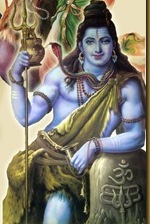KALAHASTI is a town in the Chittoor District of Andhra Pradesh. It has a temple dedicated to Lord Siva, and is famous throughout India as a sacred place and a place of pilgrimage. This religious centre, which is situated between two steep hills, called Sripuram and Mummidicholapuram, is said to have formed part of Seshasaila or Mount Meru, in the ancient days.
Kalahasti is situated near the pilgrimage town of Tirupati and is visited by thousands of pilgrims. Kalahasti temple is also associated with Rahu and Ketu, (of the nine grahams or celestial bodies in the Indian astrological scheme).
Kalahasti is situated near the pilgrimage town of Tirupati and is visited by thousands of pilgrims. Kalahasti temple is also associated with Rahu and Ketu, (of the nine grahams or celestial bodies in the Indian astrological scheme).
Historical Reference
The historical reference to this temple occur in the works of Nakkeerar, a Tamil poet in 3rd Century BC during the Tamil Sangam Dynasty. He called it as Southern Kailash.Nakkeera composed hundred stanzas to praise Srikalahasteeswara.
The hill adjacent to temple has still carvings in Pallava style. The Cholas renovated the old Pallava temple in 11th century. Kulottunga Chola I constructed the Galigopuram, the main entrance facing south and Kulottunga Chola III constructed few other temples. In 12th Century A.D., King Veeranarasimha Yadavaraya built the present Prakaras, and the four Gopurams connecting the four entrances.
According an inscription of Krishnadevaraya of Vijayanagara empire dating back to 1516 A.D., he constructed the Hundred Pillared Mantapam and the other tall Galigopuram that faces west to east. In 1529 A.D., King Achutaraya of the Vijayanagara empire got his coronation performed here, before he celebrated in his capital City.
The Legend
Lord Shiva disguised as Vayu (Air) observed that The Spider (SRI), Cobra (KALA) and Elephant (HASTI) worshipped Him very devotedly. So Lord Shiva made them to relieve from the curse and attain salvation, hence this place is called Srikalahasti. Many more Tamil Saivite saints like Sambandar, Appar, Manikkavasagar, Sundaramurti, Pattinathar and Sri Ramalinga Swami of Vadalur have also visited this place
The name of the place comes from three animals, Sri (spider), Kala (snake) and Hasti (elephant) who worshipped Shiva and gained salvation here. A statue that shows all three animals is situated in the main shrine.
The legend here is similar to that of the Jambukeswara temple at Tiruvanaikka. Shiva is said to have given salvation to a spider, elephant and a serpent who were ardent devotees of the Shiva Lingam located here. The spider is said to have attained salvation in Kritayuga (the first of the four yugas in the Hindu tradition), while the elephant and the snake were devotees in Treta Yugam, the succeeding aeon. The elephant's devotional outpouring was a source of disturbance to the serpent's display of devotion and vice versa, resulting in animosity between the two, until Shiva's intervention gave both the devotees their liberation.
Kannappa Nayanaar, a hunter is said to have been a great devotee of Kalahasteeswarar. Legend has it that he offered his own eyes to the Shivalingam, and for this reason earned the name Kannappan (his original name being Thinnan), and the distinction of having his statue adorn the sanctum. Nakkiradevar, Indra, Rama, Muchukunda and others are believed to have worshipped Shiva at this temple.
The Skanda Purana, Shiva Purana and Linga Purnas have a mention about Srikalahasti. The Skanda Purana says that Arjuna visited this place, worshipped Kalahastiswara and met the sage Bharadwaja on the top of the hill. It is believed that Kannappa (also known as Bhakta Kannappa), a tribal devotee has worshipped Siva at Srikalahasti. Tamil saints Nayanars like Appar , Sundarar and Sambanthar praised the deity in their hyms tevaram.
Brahma, the Hindu God of creation, is said to have worshipped Lord Shiva and bathed in the swarnamukhi river to get rid of "sisuhathya patakam" (the sin of killing children).
The river Swarnamukhi got its name from a belief that gold was found in its stream. Swarna means gold and Swarnamukhi means gold faced in Sanskrit.
Architecture: The huge west facing Kalahastiswara temple is built adjoining a hill, and on the banks of the river Swarnamukhi. At some points, the hill serves as the wall of the temple. The temple prakarams go after the contour of the adjoining hill and hence the temple plan is rather irregular. North of the temple is the Durgambika hill, south is the Kannappar hill and east is the Kumaraswamy hill.
Krishnadevaraya built a huge gopuram, a few feet away from the entrance to the temple. The entrance to the temple is crowned with a smaller tower. There is an underground Ganapati called Pathala Vinayagar, shrine in the outer prakaram, while in the innermost prakaram are the shrines of Shiva and Parvati.
The present structure of the temple is a foundation of the Cholas of the 10th century, as testified by inscriptions; improvements and additions were made during the subsequent years of the Chola rulers of Tamilnadu and the Vijayanagar emperors.
Significance: This ancient temple dedicated to Shiva is one of the Pancha Bhoota Stalams (temples celebrating Shiva as the embodiment of the primary elements), air being the element in case here, the other five temples being Tiruvannamalai (Fire), Chidambaram (Space),Tiruvanaikkaval (Water) and Kanchipuram (Earth) respectively.
Festivals: Maha Shivaratri which occurs in the Tamil month of Maasi (Feb 15 through March 15) is one of the greatest festival seasons here, and the celebrations are marked by processions of the deities. The fifth day of the festival in the month of Maasi coincides with the Maha Shivaratri.
Om Namah Shivaya !




